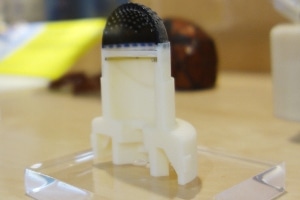Mar 22 2017
 The 3D-printed tactile robot hand on display in London's Science Museum. (Credit: University of Bristol)
The 3D-printed tactile robot hand on display in London's Science Museum. (Credit: University of Bristol)
Researchers aim to create a biomimetic forebrain which is capable of manipulating 3D-printed robot hands with a sense of touch. To achieve this, they plan on using computer modeling of a mammal’s neural system that communicates touch in animals and humans, and then apply this to carry out general manipulation operations in robots.
The research project has received £1 million funding from the Leverhulme Trust under the Research Leadership Award scheme. It will be guided by Dr Nathan Lepora from the University of Bristol and Bristol Robotics Laboratory (BRL).
The five-year research program on 'A biomimetic forebrain for robot touch' will make use of leading psychology, neuroscience, and philosophy of the brain to create a biomimetic forebrain embodied on a 3D-printed robot hand, aiming to achieve human-like tactile dexterity.
It is crucial to develop effective robot hands possessing a sense of touch for future technology because without human-like tactile dexterity, robots cannot solve the interactive operations predicted for advanced manufacturing, such as autonomous assembly lines; food production, for example picking and sorting robots; assisted living, including personal robot helpers; and healthcare, such as surgical and nursing robots.
Robots currently cannot perform these operations because no one knows ways to combine what the hands feels and how they manipulate their action. Yet evidently, this issue has been solved in the human hand and brain.
People see a robotics revolution happening but many things won’t be achieved if robots don’t have hands that they can use to dexterously control the world around them through a sense of touch. It's about bringing together tactile hands and algorithms based on how the brain works. Why is it so difficult? The human hand has evolved over tens of millions of years. People's intelligence has evolved in tandem with their hands to give them their unique role in the animal kingdom of being able to manipulate their surroundings so profoundly. So replicating that in a robotic device is both a challenge and an inspiration.
Dr Nathan Lepora, Senior Lecturer in Robotics at the University of Bristol
The Tactile Robotics research group at Bristol Robotics Laboratory studies traits of tactile sensing from hardware design to biomimetic and AI algorithms for control and perception. The group's latest effort on an open-source 3D-printed fingertip, which can 'feel' quite like the human sense of touch, won Harvard University's international Soft Robotics competition for its contribution to soft robotics research.
A 3D-printed tactile robot hand created by the group is placed on display in the Robots exhibition at the Science Museum in London.